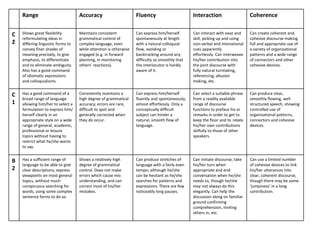
Table3
- 1. Can use a limited number of cohesive devices to link his/her utterances into clear, coherent discourse, though there may be some ‘ jumpiness ’ in a long contribution. Can initiate discourse, take his/her turn when appropriate and end conversation when he/she needs to, though he/she may not always do this elegantly. Can help the discussion along on familiar ground confirming comprehension, inviting others in, etc. Can produce stretches of language with a fairly even tempo; although he/she can be hesitant as he/she searches for patterns and expressions. There are few noticeably long pauses. Shows a relatively high degree of grammatical control. Does not make errors which cause mis-understanding, and can correct most of his/her mistakes. Has a sufficient range of language to be able to give clear descriptions, express viewpoints on most general topics, without much conspicuous searching for words, using some complex sentence forms to do so. B2 Can produce clear, smoothly flowing, well structured speech, showing controlled use of organisational patterns, connectors and cohesive devices. Can select a suitable phrase from a readily available range of discourse functions to preface his or remarks in order to get to keep the floor and to relate his/her own contributions skilfully to those of other speakers. Can express him/herself fluently and spontaneously, almost effortlessly. Only a conceptually difficult subject can hinder a natural, smooth flow of language. Consistently maintains a high degree of grammatical accuracy; errors are rare, difficult to spot and generally corrected when they do occur. Has a good command of a broad range of language allowing him/her to select a formulation to express him/ herself clearly in an appropriate style on a wide range of general, academic, professional or leisure topics without having to restrict what he/she wants to say. C1 Can create coherent and cohesive discourse making full and appropriate use of a variety of organisational patterns and a wide range of connectors and other cohesive devices. Can interact with ease and skill, picking up and using non-verbal and intonational cues apparently effortlessly. Can interweave his/her contribution into the joint discourse with fully natural turntaking, referencing, allusion making, etc. Can express him/herself spontaneously at length with a natural colloquial flow, avoiding or backtracking around any difficulty so smoothly that the interlocutor is hardly aware of it. Maintains consistent grammatical control of complex language, even while attention is otherwise engaged (e.g. in forward planning, in monitoring others ’ reactions). Shows great flexibility reformulating ideas in differing linguistic forms to convey finer shades of meaning precisely, to give emphasis, to differentiate and to eliminate ambiguity. Also has a good command of idiomatic expressions and colloquialisms. C2 Coherence Interaction Fluency Accuracy Range
- 2. Can link words or groups of words with very basic linear connectors like ‘ and ’ or ‘ then ’ . Can ask and answer questions about personal details. Can interact in a simple way but communication is totally dependent on repetition, communication. rephrasing and repair. Can manage very short, isolated, mainly pre- packaged utterances, with much pausing to search for expressions, to articulate less familiar words, and to repair Shows only limited control of a few simple grammatical structures and sentence patterns in a memorised repertoire. Has a very basic repertoire of words and simple phrases related to personal details and particular concrete situations. A1 Can link groups of words with simple connectors like ‘ and ’ , ‘ but ’ and ‘ because ’ . Can answer questions and respond to simple statements. Can indicate when he/she is following but is rarely able to understand enough to keep conversation going of his/her own accord. Can make him/herself understood in very short utterances, even though pauses, false starts and limited reformulation are very evident. Uses some simple structures correctly, but still systematically makes basic mistakes. Uses basic sentence patterns with memorised phrases, groups of a few words and formulae in order to communicate information in simple everyday situations. A2 Can link a series of shorter, discrete simple elements into a connected, linear sequence of points. Can initiate, maintain and close simple face-to-face conversation on topics that are familiar or of personal interest. Can repeat back part of what someone has said to confirm mutual understanding. Can keep going comprehensibly, even though pausing for grammatical and planning and repair is very evident, especially in longer stretches of free production. Uses reasonably accurately a repertoire of frequently used ‘ routines ’ and patterns associated with more lexical predictable situations. Has enough language to get by, with sufficient vocabulary to express him/ herself with some hesitation and circumlocutions on topics such as family, hobbies and interests, work, travel, and current events. B1 Coherence Interaction Fluency Accuracy Range